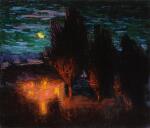
RODERIC O'CONOR | A MOONLIT BRETON LANDSCAPE
Auction Closed
November 19, 03:20 PM GMT
Estimate
120,000 - 180,000 GBP
Lot Details
Description
RODERIC O'CONOR
1860-1940
A MOONLIT BRETON LANDSCAPE
to be sold with a copy of Musée de Pont-Aven, Pont-Aven - O'Conor, 1984 exhibition catalogue and Jonathan Benington, Roderic O'Conor, 1992
studio stamp atelier O'CONOR on the reverse
oil on canvas
71 by 83cm., 28 by 32½in.
Painted circa 1898-1900.
The artist's studio sale, Hôtel Drouot, Paris, 7 February 1956;
Sotheby's, London, 2 July 1969, no.123;
Private collection, Brest;
Thierry-Lannon, Brest, 8 December 2018, lot 137;
Private collection
Paris, Grand Palais, De Pont-Aven aux Nabis - Retrospective 1888-1903 (Société des Artistes Indépendants), 16 April - 9 May 1971, no.66;
Pont-Aven, Musée de Pont-Aven, Pont-Aven - O'Conor, 30 June - 30 September 1984, no.30 (as Ronde des Korrigans), illustrated in exh. cat.
Jonathan Benington, 'From Realism to Expressionism: the Early Career of Roderic O'Conor', Apollo, April 1985, p.257;
Jonathan Benington, Roderic O'Conor, Dublin, 1992, no.84, p.199
The roots of this mysterious painting lie in the nocturnes O’Conor created during his first extended visit to Brittany. Over the summer of 1893, when based at the coastal resort of Le Pouldu, he would sometimes follow the Laïta river upstream from the coast and, as the sun went down, make etchings of groups of wind-blown trees silhouetted against the reflective water. He employed densely hatched lines to convey the loss of detail due to the gathering gloom. He also made paintings exploring similar subjects, for example Landscape with a river (Tate) in which the subject was reduced to dark blocks of colour encircling a body of water, much like the nocturnal shoreline landscapes of Edvard Munch such as Starry Night of 1893 (J. Paul Getty Museum, Los Angeles), which O’Conor could have seen at the Salon de l’Art Nouveau in Paris in 1896.
Just as the transition from day to night and the jagged profiles of trees were characteristics of O’Conor’s river views, so too have they been given a primary role here, albeit without the inclusion of water. The moon has risen behind the curtain of trees, half glimpsed through patches of dark cloud. Although the setting is rural, a house with lights in the windows is visible to the left, the facade of which seems to be illuminated by handheld torches. Shadowy figures overlook the scene, apparently a night-time festivity that shares some compositional affinity with Paul Gauguin's 1891 painting, Upa Upa (Israel Museum, Jerusalem). O’Conor is at more of a remove from the scene he was witnessing, a strategy that allowed him to focus his attention on the luminous, cloud-streaked sky and the row of silhouetted trees.
The wristy, directional brushstrokes in green, blue and red that O'Conor used to paint the sky and the trees in this landscape echo the artist's 'striping' technique of 1892-94, albeit with greater spontaneity. The painting may even have been substantially executed en plein air, until the fading light demanded that the canvas be brought into the studio for completion. Similar painterly gestures in undiluted pigment can be found in O’Conor’s Breton seascapes of 1898-9, suggesting that this work may have been created around the same time.
Jonathan Benington
